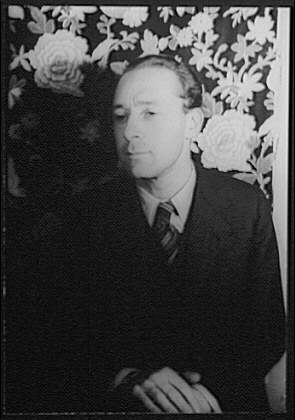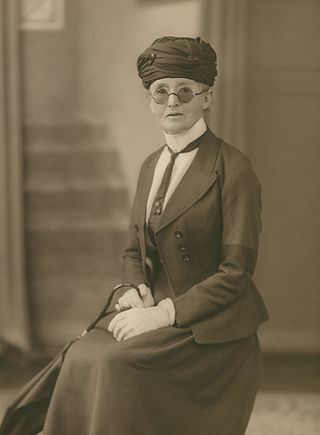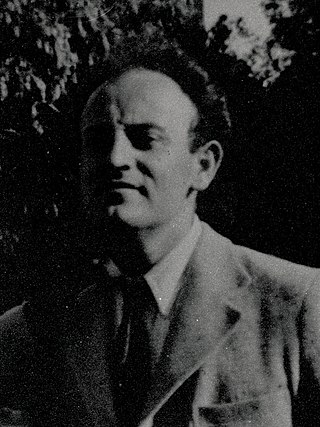Related Research Articles

A portrait is a painting, photograph, sculpture, or other artistic representation of a person, in which the face is always predominant. In arts, a portrait can be represented as half body and even full body. If the subject in full body better represents personality and mood - this type of presentation can be chosen. The intent is to display the likeness, personality, and even the mood of the person. For this reason, in photography a portrait is generally not a snapshot, but a composed image of a person in a still position. A portrait often shows a person looking directly at the painter or photographer, to most successfully engage the subject with the viewer, but portrait can be represented as a profile and 3/4.

Pavel Fyodorovich Tchelitchew was a Russian-born surrealist painter, set designer and costume designer.

Daisy May Bates, CBE was an Irish-Australian journalist, welfare worker and self-taught anthropologist who conducted fieldwork amongst several Indigenous nations in western and southern Australia. Some of the Ngaanyatjarra and Ngaatjatjarra people referred to Bates by the courtesy name Kabbarli "grandmother." In the 1970's in Yalata, she was referred to as mamu, meaning ghost or devil, and as "that poor old lady at Ooldea".

Ernestine Hill was an Australian journalist, travel writer and novelist. Known for her various travels across Australia and her writings about the diverse landscapes and cultures in the country, she published books such as The Great Australian Loneliness in 1937 and The Territory in 1951. She also wrote a novel, My Love Must Wait, published in 1941.
Stephen Finer is a London-based artist, active since the 1980s.
Norbert Casper Lynton was Professor of the History of Art at the University of Sussex. From 1998 - 2006 he was Chairman of the Charleston Trust.

Ooldea, known as Yuldea and various other names by Western Desert peoples (Aṉangu), is a tiny settlement in South Australia. It is on the eastern edge of the Nullarbor Plain, 863 km (536 mi) west of Port Augusta on the Trans-Australian Railway. Ooldea is 143 km (89 mi) from the bitumen Eyre Highway.
John Beard is a Welsh artist and painter born in Aberdare, Wales, now based in Sydney, Lisbon and London.
Painting the Century: 101 Portrait Masterpieces 1900–2000 was an international exhibition held at the National Portrait Gallery in London in 2000–2001 that exhibited a painting representing each year of the 20th century. A book of the same name was published by the National Portrait Gallery by Robin Gibson with an introduction by Professor Norbert Lynton that illustrates all works exhibited.

Diana and Actaeon is a painting by the Italian Renaissance master Titian, finished in 1556–1559, and is considered amongst Titian's greatest works. It portrays the moment in which the hunter Actaeon bursts in where the goddess Diana and her nymphs are bathing. Diana is furious, and will turn Actaeon into a stag, who is then pursued and killed by his own hounds, a scene Titian later painted in his The Death of Actaeon.

Diana and Callisto is a painting completed between 1556 and 1559 by the Italian late Renaissance artist Titian. It portrays the moment in which the goddess Diana discovers that her maid Callisto has become pregnant by Jupiter. The painting was jointly purchased by the National Gallery and the Scottish National Gallery for £45 million in March 2012. Along with its companion painting Diana and Actaeon it is displayed on an alternating basis between London and Edinburgh. There is a later version by Titian and his workshop in the Kunsthistorisches Museum in Vienna.
Philip Harris is a British born artist who won first prize in the National Portrait Gallery's 1993 BP Portrait Award for portrait painting with the painting 'Two Figures Lying in a Shallow Stream'. Harris was commissioned by the National Portrait Gallery to paint Sir Anthony Dowell, the director of The Royal Ballet.
Robin Warwick Gibson was a British gallery curator and art historian best known for his work at the National Portrait Gallery in London between 1968 and 2001, including eight years as Chief Curator. He was responsible for many innovations in the management of the gallery and published a number of significant academic works on the gallery's collections during his career.

Constance Stokes was an Australian modernist painter who worked in Victoria. She trained at the National Gallery of Victoria Art School until 1929, winning a scholarship to continue her study at London's Royal Academy of Arts. Although Stokes painted few works in the 1930s, her paintings and drawings were exhibited from the 1940s onwards. She was one of only two women, and two Victorians, included in a major exhibition of twelve Australian artists that travelled to Canada, the United Kingdom and Italy in the early 1950s.

Sir Sidney Robert Nolan was one of Australia's leading artists of the 20th century. Working in a wide variety of media, his oeuvre is among the most diverse and prolific in all of modern art. He is best known for his series of paintings on legends from Australian history, most famously Ned Kelly, the bushranger and outlaw. Nolan's stylised depiction of Kelly's armour has become an icon of Australian art.

Florence Ada Fuller was a South African-born Australian artist. Originally from Port Elizabeth, Fuller migrated as a child to Melbourne with her family. There she trained with her uncle Robert Hawker Dowling and teacher Jane Sutherland and took classes at the National Gallery of Victoria Art School, becoming a professional artist in the late 1880s. In 1892 she left Australia, travelling first to South Africa, where she met and painted for Cecil Rhodes, and then on to Europe. She lived and studied there for the subsequent decade, except for a return to South Africa in 1899 to paint a portrait of Rhodes. Between 1895 and 1904 her works were exhibited at the Paris Salon and London's Royal Academy.

Lady Agnew of Lochnaw is an oil on canvas portrait painting of Gertrude Agnew, the wife of Sir Andrew Agnew, 9th Baronet. The painting was commissioned in 1892 and completed the same year by the American portrait artist John Singer Sargent. It measures 127 × 101 cm (50.0 × 39.8 in) and is owned by the Scottish National Gallery in Edinburgh, Scotland. The museum acquired it through the Cowan Smith Bequest Fund in 1925.
Daisy Mary Rossi was an Australian artist, interior designer and writer. She is best known for painting portraits and impressionist landscapes and flowers.

The Wirangu are an Aboriginal Australian people of the Western coastal region of South Australia.

Gray Smith was an Australian artist, poet and jeweller who was part of the Heide Circle. While best known as the famous Australian artist Joy Hester's spouse, his most productive artistic period came later while married to Joan Upward in the '60s and '70s. Smith's modernist paintings often featured isolated figures in Australian outback landscapes.
References
- ↑ Warwick Gibson, Robin. Painting the Century: 101 Portrait Masterpieces 1900-2000. London: National Portrait Gallery, 2000. ISBN 1-85514-289-9, p. 160